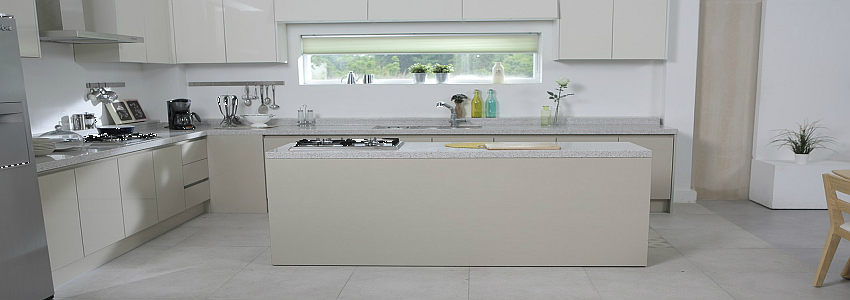The floor is one of the most used elements in a house. However, the most used one is probably the kitchen floor, a space with various functions, from cooking and family reunions or other activities.
The kitchen floor has to face heavy traffic in this area, but also appearance is important because it reflects the style of the house where you live in.
How can you reconcile these two criteria in order to have a durable floor and that at the same time to represents you? For what kind of materials should you opt for?
Ceramic tiles
Ceramic tiles are a safe choice for a kitchen and can be purchased regardless of budget. You have a wide range of colors, sizes, shapes and patterns to choose from, so you can create an image that fits best with your style and your family.
Among the advantages of this material is the fact that is very durable and easy to clean. The wide variety of options at low prices makes it one of the materials that you can afford, even if you plan a remodeling on a budget.
Among the disadvantages is the fact that these tiles can break during installation, and if a pot or a cup falls onto the floor, the tiles can be destroyed. In addition, if you walk directly on them, you have a sensation of cold feet. The floor is pretty rough and becomes slippery when wet. It’s a material that needs constant maintenance to keep stains away.
Natural stone
Whether it’s limestone, slate or travertine,, natural stone floors have a major advantage: variation. No two stones have exactly the same color, shape or texture, and the differences create a visual depth that is difficult to copy.
Stone creates an elegant look that turns an ordinary kitchen into a luxurious one.
Among the advantages of natural stone, it includes a classic look that you give your room, its durability and the fact that it doesn’t require special care. In addition, the natural beauty of stone is a great asset.
Disadvantages include the high price of stone, the fact that crevices on the surface attract dust and scratches can occur to some softer stones, such as travertine, while slate layers peel off with time. Porous stones will need special care at regular intervals.
Hardwood floor
Nature is a wonderful artisan and solid wood gives the room a welcoming and attractive appearance. Even in areas with a high moisture level and where you cook much, wood has an extremely high lifetime, if cared for properly.
It gives a classic look to the room, regardless of the type of wood you choose, and it will always look good in the kitchen. Wood will always be in fashion, so no need to worry regarding trends in decorations.
The wood can be sanded to make it look like brand-new.
Some disadvantages are that you must always take care with liquids, because they damage the wood if you don’t quickly erase the area were you spilled something.
Vinyl
Vinyl is available on the market in a wide range of designs and finishes. It’s available in sheets or tiles that mimic stone, wood, tile and many other materials, or printed with textures that give a natural look.
Among the advantages are that it is one of the cheapest options for a kitchen floor, imitating expensive materials at a very low price. It is easy to clean, easy to repair if something smears and it feels very comfortable to the feet. In addition, you can install it easily.
The disadvantages of choosing this material are that it can cut or bend over time. Sharp objects may cause damage, and the sand and dirt can scratch and damage the finish. Also, if exposed to strong sunlight, it fades. Compared with other materials for the floor, it has a shorter lifespan, of about five years.
Linoleum
There is often confusion between linoleum and vinyl, but the two are completely different things. Linoleum, a natural material made from linseed oil, resin, sawdust and many other substances was replaced on the top choices in the market when synthetic floors appeared.
In recent years, this material has gained the interest of people concerned with environmental protection. It’s perfect for old-fashioned houses.
One of the advantages is that linoleum is found in many colors and patterns, so you can choose what suits you best. It’s not an material, has a long life span and is easy to maintain.
Disadvantages include that it fades over time. Many manufacturers add a protective layer before selling linoleum; without it, the floor would require waxing and polishing systematically. Also, it takes a professional to install it.
Cork
Cork won in popularity in recent years. This is not a material for everyone, but those who love it, appreciate its forms, texture, appearance and the fact that it’s particularly environmentally friendly.
Cork is a flexible material that offers a high comfort when you walk on it and reduces the shock of a fall in case of plates or cups. Cork usually comes in warm tones, giving a feeling of comfort in the kitchen.
Cork is rich in a natural substance that repels mold and various pests.
However, it is a material that needs to be maintained constantly with various substances. It can be destroyed and fades over time.
No matter which type of floor you choose, the Good Deal Remodeling team is specialized in home remodeling projects, especially kitchen remodel and bathroom remodeling. You can contact us to tell us what you have in mind, and we will make sure that you will have the kitchen of your dreams.

